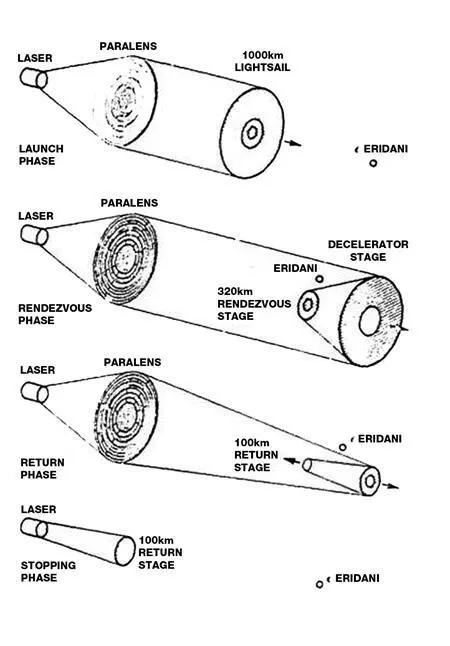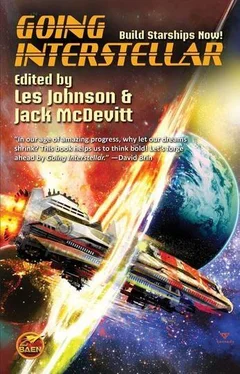As discussed above, the thrust on a solar sail increases as its distance from the Sun decreases. Some pioneering work by Drs. Gregory Matloff and Roman Kezerashvili shows that an approximately one mile diameter solar sail spacecraft weighing no more than seven hundred pounds passing very, very close to the Sun, within about nine million miles, could achieve a solar-system exit velocity of two hundred and fifty miles per second. A craft traveling this fast would pass the Earth in four days, Jupiter in twenty one days and reach the Alpha Centauri system in just over three thousand years. By comparison, the fastest rocket we’ve ever sent into space won’t cover the distance to the Alpha Centauri system for another seventy-four thousand years! By increasing the sail size, and keeping the payload mass the same, we can see an engineering path to building a sail that could cover this immense distance in about a thousand years. For you and me, there isn’t much difference between a thousand years and seventy four thousand years. But in the lifetime of civilizations, the difference between these numbers is significant. We have recorded history going back a thousand years and there is no reason to assume that we won’t have similar records going forward; however seventy-four thousand years goes back well beyond the origins of human civilization.
You might have noticed another problem with the relatively near-term solar sail—it weighs only seven hundred pounds. Unfortunately, to carry a larger mass—millions of tons are required to carry and sustain humans on such a voyage—would require a solar sail of immense proportions (think the size of continents) made of incredible materials (“unobtainium” comes to mind). While such sails don’t violate any known laws of physics, we currently are almost clueless regarding how to engineer them.
One approach to creating these massive sails is to build them in space, so that they don’t have to experience the stresses of riding a rocket to get them there. This would solve two problems at the same time. First of all, the rocket launch will be the most stressful of the mechanical environments which the sail must be designed to survive. Rockets are not known for slow and graceful acceleration or for being a smooth ride. Quite the opposite is true; consequently, building a gossamer sail strong enough to ride on a rocket will be difficult. Second, the manufacturing of extremely large, lightweight and fragile solar sails in Earth’s gravity will be nearly impossible. The forces experienced by just being here on the surface may be sufficient to cause tears in the sail. Overcoming the stresses experienced as the sail is folded and packaged, as well as surviving the effects of Earth’s gravitational acceleration, will likely be both complex and expensive. When compared to the Earth, the space environment is much kinder to solar sails.
Building sails in space will not be so easy either. Manufacturing anything in space implicitly assumes there is some sort of facility or location where the construction will take place. This place itself must be built and launched. Then there’s the raw materials part. Sails, though conceptually simple, are anything but simple when we consider their subsystems and components: lightweight, highly reflective membranes; lightweight structures; moving parts for attitude control; electronics for deployment, attitude control, and navigation; plus many others. All of these, at least here on Earth, come through an extensive supply chain all the way from the extraction of the raw materials from which they are made to the final fabrication in a factory somewhere in the world. It’s only after the system integrator orders all the right parts that the engineers and technicians can even begin putting it together. All of this would have to be re-created in space to enable in-space manufacturing of a very large solar sail.
There is another approach that takes advantage of the Earth’s well-established manufacturing infrastructure and the unique environment of space to solve the manufacturing and launch problems: build the sail on Earth, but make it more robust—thicker—than the mission requires and make the extra thickness out of materials that won’t easily tear when in the Earth’s gravity and that will not damage easily during launch. But, design the more robust sail so that the heaviest part will evaporate when exposed to a selected portion of the Sun’s ultraviolet light—which only happens when we are above the Earth’s atmosphere. Voila! The thick and heavy sail that was easier to make and launch quickly becomes the wispy, lightweight sail needed for rapid propulsion through interstellar space.
This might just work.
The single largest constraint on an interstellar spacecraft propelled by a solar sail is the “solar” part. If the ship must get all of its thrust from the Sun, then it is constrained to do so before it passes the orbit of Jupiter (in just a couple of weeks) because the Sun gets very dim at this point and the additional thrust the ship would obtain from the ever-more-distant Sun is minimal. It is very difficult to get enough energy from the Sun for a voyage to another star—especially in a few days or weeks. How then can we build a sail and continue to use light pressure to accelerate even after the sail is beyond the reach of sunlight?
Lasers may solve this problem. A laser provides a tightly focused beam of light across large distances and might be capable of providing enough light to continue pushing our sail during its journey through interstellar space. An interesting approach to using laser energy for interstellar solar sailing was described by the late physicist, engineer and author extraordinaire, Dr. Robert Forward. As early as 1962 Forward was publishing technical papers describing how a future sail might be pushed through deep interstellar space by a powerful laser orbiting the Sun.
On the scales that we typically use lasers, say in the few tens of feet or less, the beam appears to be tightly focused without significant divergence, or beam spread. But over millions of miles, even the best laser beam will diverge and become more diffuse. In order to keep a relatively small beam focused on our interstellar sail, we will need to build a six hundred mile diameter focusing lens at about the orbit of Jupiter through which we will shine our laser.
Using a spacecraft of similar weight to the one described above for the Sun-only solar sail, and using a sail of about the same size, Forward calculated that a sixty-five Gigawatt laser could accelerate our sail to a velocity of one-tenth the speed of light. This would enable our spacecraft to reach Alpha Centauri in only a little more than forty years after launch. A substantial improvement over three thousand years!
Unfortunately, we don’t know how to build continuously operating sixty-five GW lasers, nor do we know how to build six hundred mile diameter lenses orbiting the Sun near Jupiter. Our physics is once again ahead of our engineering—but we won’t let that stop us!
Forward went on to show that a sail craft of much more interesting (from the point of view of future human interstellar exploration) sizes, say six hundred miles in diameter and weighing almost two million pounds, could have the same forty-year trip time if a seven-Terawatt laser were used (Figure 7). I should point out that the annual total power output for the human race is approximately 1 TW. Again, there is no physical reason this cannot be done. The challenge, as physicists are often fond of saying, is in the engineering. BUT IT IS POSSIBLE.

Figure 7. Robert Forward’s interstellar light sail concept shown as it appeared in his Advanced Space Propulsion Study for the Air Force Astronautics Laboratory in 1986.
Читать дальше













